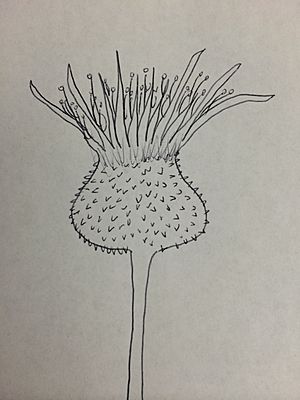Wright's marsh thistle facts for kids
Quick facts for kids Cirsium wrightiiWright's marsh thistle |
|
|---|---|
 |
|
| Left: Sketch of Cirsium wrightii | |
| Scientific classification | |
| Genus: |
Cirsium
|
| Species: |
wrightii
|
| Synonyms | |
|
|
Wright's marsh thistle (scientific name: Cirsium wrightii) is a special plant found in North America. It belongs to the sunflower family. This plant is considered an endangered species, which means it is at risk of disappearing forever.
This amazing thistle can grow very tall, sometimes reaching up to 300 cm (about 10 feet)! It is a type of perennial plant, meaning it lives for more than two years. However, it is also "monocarpic," which means it only flowers once in its life before it dies.
The first time this plant was found and collected was in 1851 in Arizona. It was discovered by a botanist named Charles Wright, which is how it got its name.
Contents
Where Does Wright's Marsh Thistle Live?
Today, Wright's marsh thistle is only found in a few places. You can mostly find it in just 7 counties in south-central New Mexico.
In the past, this plant used to grow in more areas, including Sonora and Chihuahua in Mexico, and also in Texas and Arizona in the United States. Scientists believe that things like drought (when there isn't enough water) have caused the plant's habitat to shrink. Since these thistles love wet places, a lack of water is very bad for them.
Habitat and Life Cycle
Wright's marsh thistle loves wet places, just like its name "marsh thistle" suggests. It grows best in moist areas such as mountain slopes, forests, and marshes. You can also find it near the edges of rivers and ponds.
These plants often grow in low-lying wetlands, even in dry desert areas. They prefer alkaline soils, which are a type of soil with high pH.
This plant grows for a few years, then flowers in its second year. It usually blooms between August and October. Sometimes, Wright's marsh thistle can grow close to other thistle types, like Cirsium texanum and Cirsium vinaceum. When they grow together, they can sometimes create new hybrid plants!
What Does Wright's Marsh Thistle Look Like?
One of the most noticeable things about Wright's marsh thistle is how incredibly tall it can get. It can reach heights of up to 300 cm (10 feet)!
The plant has a main stalk, which is like its central stem. Leaves grow along this stalk, and many flowering branches grow from the stem too. The stem also has prickly spines, which are sharp points that stick out.
Both the leaves on the stem and the leaves at the bottom of the plant (called basal leaves) are thick and juicy, almost like a succulent. The basal leaves are prickly and can be about 30 cm long. The longest branches on the plant are the ones that have flowers. Each of these many branches has a flower head at its end. The tips of the flower styles (part of the flower) are about 3 mm long and can be white or a pale pink color.
Why Is This Plant Endangered?
The United States Fish and Wildlife Service considers Cirsium wrightii a candidate for the endangered species list. This means they are thinking about adding it to the official list of plants that need protection. It has a "listing priority" of 8, which means other species need more urgent help right now.
An organization called WildEarth Guardians believes that Wright's marsh thistle is at high risk of extinction. They asked for this species to be added to the Endangered Species Act on October 9, 2008.
Threats to the Thistle
There are several reasons why this plant is in danger.
- Water availability: Since it's a marshland plant, it needs a lot of water all the time. But the places where it lives can often experience droughts. The amount of water available depends on how much rain soaks into the ground each year.
- Habitat loss: When the places where the thistle lives are destroyed or changed, it loses its home. This can also lead to new plants, sometimes invasive species, moving in and competing with the thistle for resources.

